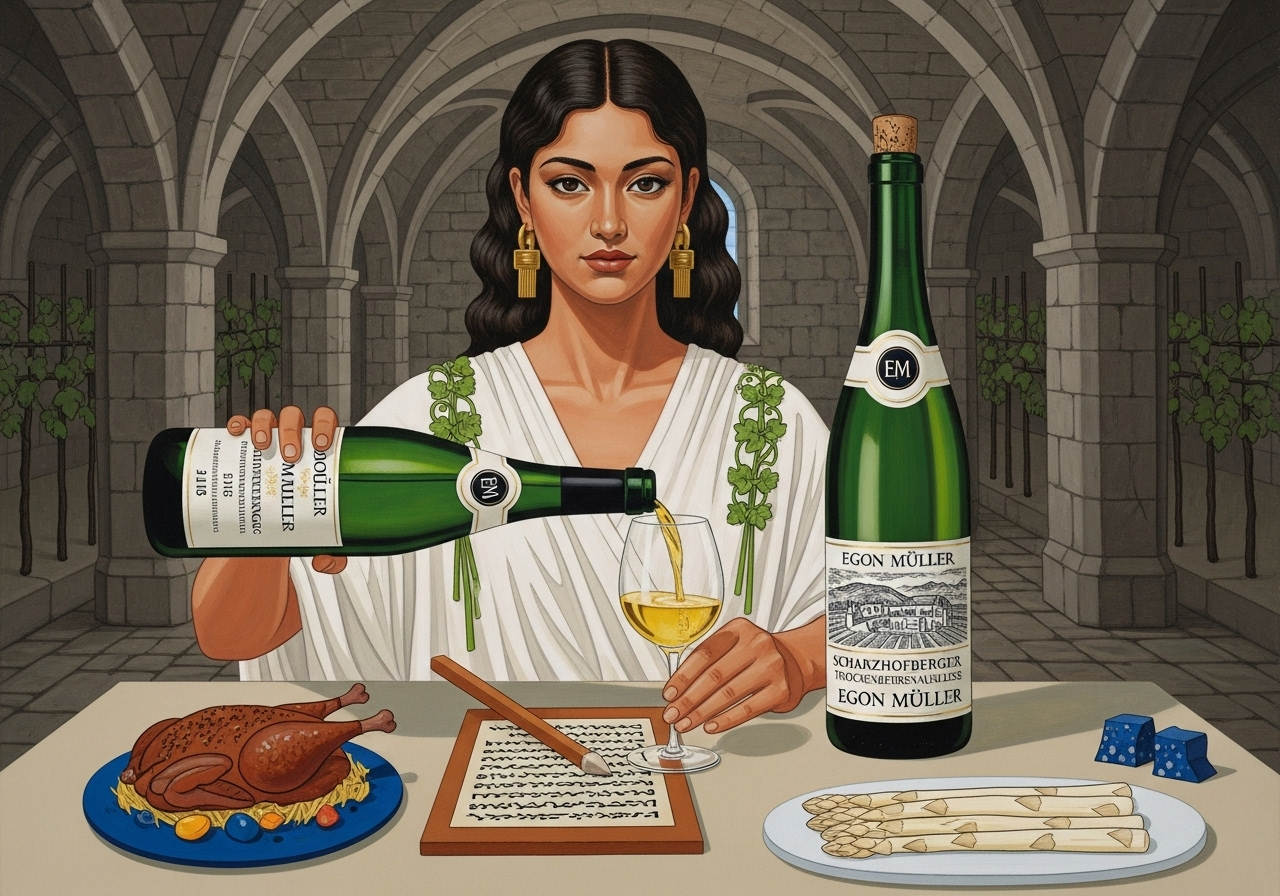Amber Silence of the Saar: Egon Müller Scharzhofberger Riesling Trockenbeerenauslese 2018
Ethereal and Saar-born—discover visionary pairings for [Egon Müller Scharzhofberger Riesling Trockenbeerenauslese 2018 food pairing].

The wine glows like a captured dawn. When I, Gesh—the vine goddess, scribe of the underworld—pour the 2018 Egon Müller Scharzhofberger Riesling Trockenbeerenauslese, the glass fills not just with liquid but with time itself. The color is molten topaz, its light trembling as though it remembers the sun. I let it rest for half an hour in open air—a brief resurrection before its next descent—and serve it cool at 10 °C in a tall tulip glass that cradles its perfume. It needs no swirl of ceremony. The first breath of aroma—dried apricot, saffron, candied lime peel, and honeycomb dusted with smoke—calls back to the cellar mist and the patient decay that birthed it.
The Vineyard Between Worlds
High above Wiltingen, the Scharzhofberg catches both the river’s breath and the forest’s shadow. Egon Müller’s vines are old and thin, their roots gripping shattered slate like a hymn carved into stone. From this place—where fog lingers like incense and sunlight arrives reluctantly—Riesling becomes something not of earth but of transition. The 2018 vintage was a season of generosity; yet here, generosity means restraint. The noble rot arrived late and elegant, a slow gilding of the berries. What was gathered was essence, not abundance: sweetness born from surrender.
The Taste of Captured Light
On the tongue, this TBA feels both endless and weightless, like a prayer spoken underwater. Flavors of kumquat preserve, bergamot oil, and crystallized ginger rise through honeyed texture and razor-fine acidity. Beneath it, the mineral hum of slate keeps the wine earthbound, anchoring its celestial sweetness. I have known such balance before—in dreams where I recorded the names of mortals who refused to fade. This wine does the same: it remembers what the sun once promised and what the mist took away.
Flesh Against Gold: The Savory Communion
I would pair it first with pigeon roasted in hay and brushed with quince glaze, the sweetness wrapping the smoke like memory over flame. Or with crayfish in Riesling butter and wild fennel pollen, the sea’s brine meeting the wine’s sweetness in a shimmer of equilibrium. These are pairings that taste of autumn’s edge—the moment before decay becomes beauty. The salt sharpens the wine’s glow; the acid cleanses the soul of excess.
The Golden Mirror: Sweetness Reimagined
For those who would answer sweetness with sweetness, restraint must become devotion. Baked mirabelle plums in saffron custard draw forth the same golden notes that hide in the wine’s depths, while caramelized brioche with lemon balm and bee pollen turns texture into harmony—the crisp crust echoing the slate’s mineral bite. These pairings are not indulgence; they are reflection. In sweetness, the wine finds its double, and the mirror becomes endless.
The Whispering Slate: Earth Finds Its Voice
For the bold, there is a third path—pairing the wine with earth’s quiet hum. White asparagus roasted with hazelnut oil and truffle salt builds a bridge from root to fruit, the umami softened by sweetness. Or pumpkin soup infused with kaffir lime and roasted shallot ash, where the acidity slices through the velvet broth like lightning over river water. These are dishes that do not resist the wine but kneel to it, allowing the Saar’s whisper of stone to linger in the finish.
My Descent Among the Vines
In each drop I hear the echo of my own myth: half a year among the roots, half beneath the living sun. Scharzhofberg, too, lives this rhythm—the vine’s sleep beneath frost, the flood of light in spring. The 2018 TBA carries both worlds: ripeness and ruin, sweetness and ash. When I sip it, I feel the scroll in my hand, the stylus of carnelian tracing names that will not be forgotten. Such wines are the underworld’s brightest offerings—what mortals call decadence, I call remembrance.
The Ritual of Golden Stillness
Serve it as you would a relic of sunlight: 10 °C, no colder. Let it breathe, let it expand. A small pour suffices; the flavor multiplies in silence. Once opened, the bottle keeps for days, its sweetness deepening into spice and smoke. Cellared properly, it will still sing when generations have turned to parchment. Age does not fade it—it translates it, like me, into language eternal.
The Blessing of the Scharzhofberg
Some wines sing of fruit or oak or fame. This one sings of patience. It listens—to mist, to stone, to the quiet between harvest and frost. To drink it is to understand the Saar: the beauty of waiting, the grace of rot, the courage of restraint. May those who taste it remember—every sweetness carries its shadow, and in that shadow lies the light.





